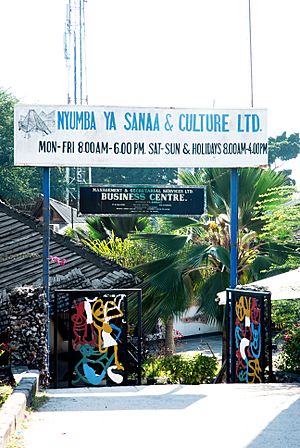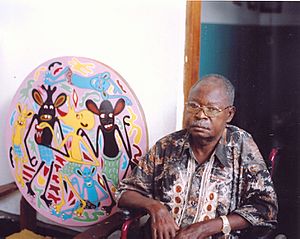George Lilanga facts for kids
George Lilanga (1934–27 June 2005) was a famous painter and sculptor from Tanzania. He created art from the late 1970s until the early 2000s. Lilanga was a member of the Makonde people and spent most of his life in Dar es Salaam, the largest city in Tanzania.
His artwork was shown in many international art exhibitions. These included Africa Remix in 2004 and African Art Now in 2005. Because of these shows, art critics and collectors became very interested in his work. Lilanga became the most well-known artist from Tanzania around the world.
At first, he made sculptures from wood, following the traditional Makonde art style. Later, he visited a cultural centre called Nyumba ya Sanaa (which means House of Art). There, he saw other modern artists. This inspired him to change his sculptures into two-dimensional art, like paintings and etchings. He developed his own unique style using the Shetani (meaning devils) figures from modern Makonde sculptures. His paintings are famous for their bright colours and funny style. They show everyday life in Tanzania as he saw it.
Contents
About George Lilanga's Life
The exact place and date of Lilanga's birth are not fully known. However, he said he was born in 1934 in a village called Kikwetu. This village is in the Masasi district of the Mtwara Region in southern Tanzania.

Both of Lilanga's parents were Makonde people. This is an ethnic group found in both Mozambique and Tanzania. His father worked on sisal plantations, which grow plants used for making ropes. Lilanga had two brothers who passed away before him. He only went to primary school for three years. In his later artworks, he often painted scenes from village life. He sometimes showed happy memories of students getting their diplomas at school.
In 1970, Lilanga decided to move to Dar es Salaam. He knew there would be more chances to sell his sculptures and create modern art there. In 1971, he found his first job thanks to his uncle, Augustino Malaba. His uncle was already a well-known sculptor and would later work with Lilanga. Lilanga worked as a night guard at the House of Art (Nyumba ya Sanaa). This centre helped develop African art and crafts in Dar es Salaam.
An American aid worker named Jean Pruitt noticed Lilanga's talent very quickly. Lilanga invited other artists, like Robino Ntila and Patrick Francis Imanjama, to join Nyumba ya Sanaa. He also started painting on batik cloth, goatskin, and metal sheets. These metal paintings were used to decorate the railings and gates of the centre.
Lilanga was part of the art scene in Dar es Salaam, including the successful Tingatinga art school. However, he always kept his own unique style. After 1972, he mostly became a painter. Some of his paintings were shown at Dar es Salaam's National Museum in 1974.
In 1977, he traveled outside Africa for the first time. He went to New York, where he had an art show. He stayed in Manhattan for a short time, selling his prints on paper or cardboard on the streets.
Health Challenges
In 1974, doctors told Lilanga he had diabetes mellitus. He said, "I was always very tired and couldn't do my normal daily routine. So, I decided to get a full checkup at the local hospital. That's when the doctors found out I had diabetes."
In the late 1990s, his diabetes became much worse and caused serious problems. Lilanga had to change how he worked. He set up an atelier, which is a workshop, with many young students and his own relatives. They were also sculptors and painters. Lilanga watched them closely, and they started to help him with some of the work he could no longer do easily by himself.
By 2000, a combination of diabetes, high blood pressure, and heart disease made Lilanga's health get worse quickly. In October 2000, he had to have his right leg removed because of gangrene. In December of that same year, his left leg was also removed. Lilanga then had to use a wheelchair. But after returning home in January 2001, he started working on his art again.
Because of his serious health issues, in 2001, he mostly returned to making smaller artworks. He used ink on paper and small goatskins, which were quicker and easier to create. However, with the help of his atelier, he also continued to make large paintings. He produced big canvases and round artworks called tondos until shortly before he passed away.
Lilanga died on Monday, June 27, 2005, at his home and studio in Mbagala, Dar es Salaam.
Lilanga's Artistic Legacy
George Lilanga's colourful artworks show a fun and creative change from traditional Makonde art. His art often features the fantastic creatures called shetani, which are found in almost all of his paintings and sculptures. Traditionally, Makonde sculptors chose the best woods for their pieces and would not paint over the wood's natural look.
Lilanga's new technique of using bright, multi-coloured enamel paint gave his art a more modern and appealing look. This became his personal style and made his works popular with collectors and art dealers. As a result, Lilanga became a very important artist in African art. He had great commercial success later in his life, and the prices for his artworks increased even more after his death in 2005.
However, many artworks have been sold as "Lilangas" just because they look like his style. Since hundreds of pieces are sold as "Lilangas," it's clear that George Lilanga could not have made all of them himself. This is especially true because his health was poor during the last ten years of his life, which is when most of these pieces were made.
The truth is that George Lilanga taught and inspired several artists who worked with him. These artists used the popularity of the "Lilanga" name. After George Lilanga died, some of these artists and new ones continued to create art that was sold under the Lilanga name.
Many of George Lilanga's artworks can be found in important international collections. These include The Contemporary African Art Collection (CAAC) owned by Jean Pigozzi and the Hamburg Mawingu Collection HMC of German collector Peter-Andreas Kamphausen. Right after the artist's death, the HMC: George Lilanga Collection published the first complete catalogue of Lilanga's work. This book also explores the traditional roots of East African Makonde art. It covers four decades of Lilanga's artistic journey, showing his use of different materials and techniques, such as sculpture, paintings, etchings, drawings, and metal works. The HMC also publishes the George Lilanga News online. This blog shares information about the artist, his artworks, exhibitions, and other interesting facts. In 2005, a well-illustrated book about Lilanga's work was also published as part of the African Collection series.
Major Art Exhibitions
Solo Exhibitions
- 2012 George Lilanga: Inside...Africa...Outside, Hamburg Art Week/Hamburg Mawingu Collection (HMC), Germany
- 2005 George Lilanga, Jamaica, Milan, Italy
- 2004 Tingatinga and Lilanga, Kouchi Prefecture Art Museum, Kouchi, Japan
- 2003 Lilanga d’ici et d’ailleurs, Centre Culturel François Mitterrand, Périgueux, France
- 2003 George Lilanga, Christa’s Fine Tribal Art Gallery, Copenhague, Denmark
- 2002 George Lilanga, MAMCO, Geneva
- 1999 George Lilanga "Storie Africane", Franco Cancelliere Arte Contemporanea, Messina, Italy
- 1995 Lilanga Artist in Residence and Workshop, Hiroshima City Moderne Art Museum, Japan
- 1994–1995 Lilanga's Cosmos, Okariya Gallery
Group Exhibitions
- 2010 African Stories, Marrakech Art Fair, Marrakech
- 2007 Why Africa?, Pinacoteca Giovanni e Marella Agnelli, Turin, Italy
- 2006 100% Africa, Guggenheim Museum, Bilbao, Spain
- 2005 Arts of Africa, Grimaldi Forum, Monaco, France
- 2005 African Art Now : Masterpieces from the Jean Pigozzi Collection, Museum of Fine Art Houston, USA
- 2004 Africa Remix, Art contemporain d’un continent, in Paris, London, Düsseldorf and Tokyo
- 2003–2004 Latitudes, Hôtel de Ville, Paris, France
- 2002 Mapico Dance, MAMCO, Geneva, Switzerland
- 2000–2001 Shanghai Biennale 2000, Shanghai, China



